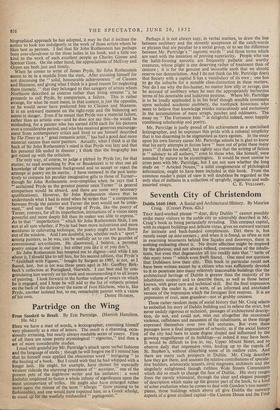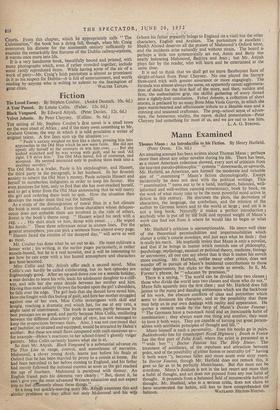Seventh City of Christendom
THAT hard-worked phrase " dear, dirty Dublin " cannot possibly strike many visitors to the noble city so admirably described in Mr. Craig's book as being particularly revealing. This compact capital, with its elegant buildings and delicate vistas, gives no outward warrant for intimate and back-handed compliments. Dirt there is, but mostly swept up into comers ; and when it is found, as often as not in swarming tenements behind fine facades and doorways, there is nothing endearing about it. No doubt affection might be inspired by the glorious, and not always refined, conversation of the inhabi- tants, but even that degenerates all too readily into that " tattle of this nasty town " which even Swift feared. One need not question that Dubliners love their city. This book in particular could not have been written except by a citizen who was sufficiently devoted to it to penetrate into many relatively inaccessible buildings (for the architectural heritage of Dublin is greater than the majority of its inhabitants suspect) and to describe them, as well as those better known, with great care and technical skill. But the final impression left with the reader is, as it were, of an informed and annotated version of the impression which the foreigner first receives. It is an impression of cool, sane grandeur—not of grubby cosiness.
Those rather random items of social history that Mr. Craig selects to embellish his story of Dublin building and to relieve the strict, but never unduly rigorous or technical, passages of architectural descrip- tion, do not, and could not, miss out altogether the occasional violence, raffishness and meanness of the inhabitants, as these things expressed themselves over two full centuries. But even these passages leave a final impression of urbanity, as if the social history of'the city had been to some degree shaped and influenced by the growing magnificence of its buildings—as indeed it may have been. It would be difficult to live in, say, Upper Mount Street, and to observe daily that impressive vista, leading up to the cupola of St. Stephen's, without absorbing some of its mellow calm. And there are many such prospects in Dublin. Mr. Craig describes how they got there, and assesses the relative contributions of specula- tive builders, aristocratic tenants, civic magnates, architects and the singularly enlightened though ruthless Wide Streets Commission which did so much to change the face of Dublin. His story ranges from the merely whimsical, through the clear and elegant passages of description which make up the greater part of the book, to a kind of sober exaltation when he comes to deal with Gandon's two master- pieces, those buildings which above all give Dublin the outwarp aspects of a great civilised capital—the Custom House and the Four Courts. From this chapter, which he appropriately calls " The Culmination," the book has a dying fall, though, when Mr. Craig overcomes his distaste for the nineteenth century sufficiently to examine the remarkably fine features of the Dublin railway-stations, it warms once more into life.
It is a very handsome book, beautifully bound and printed, with many photographs which, even if rather crowded together, include some rarely reproduced items. While having some of the air of a work of piety—Mr. Craig's Irish patriotism is almost as prominent in it as his respect for Dublin—it is full of entertainment, and worth reading by anyone who is willing to submit to the fascination of



















































 Previous page
Previous page